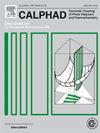评估催化裂化 Al-X(X=锌、镁)和 Al-Zn-Mg 合金的导热性:实验和建模
IF 1.9
3区 材料科学
Q4 CHEMISTRY, PHYSICAL
Calphad-computer Coupling of Phase Diagrams and Thermochemistry
Pub Date : 2024-10-28
DOI:10.1016/j.calphad.2024.102763
引用次数: 0
摘要
导热性是铝合金的关键热物理性质之一。然而,与机械性能相比,专注于研究 Al-Zn-Mg 等铝合金及其子系统导热性能的研究较少。本研究旨在结合实验和建模来评估催化裂化铝锌、铝镁和铝锌镁合金的导热性。首先采用 CALPHAD(PHAse Diagram 计算)方法设计了催化裂化铝锌、铝镁和铝锌镁合金。使用真空感应熔炉制备合金样品,并通过 ICP(电感耦合等离子体)、XRD(X 射线衍射)和 SEM(扫描电子显微镜)验证其成分和结构。此外,还在 CALTPP(热物理特性计算)软件中加入了一个新模型,用于评估催化裂化铝锌、铝镁和铝锌镁合金在 298 K 至 498 K 的热导率。模型评估的热导率与测量值之间的所有偏差都在±10%以内,表明本计算结果是可靠的。此外,本研究还利用所开发的模型预测了催化裂化铝锌、铝镁和铝锌镁合金随成分和温度变化的热导率。本研究提供了一种结合实验和建模研究单相固溶体热导率的有效方法。本文章由计算机程序翻译,如有差异,请以英文原文为准。
Assessment of thermal conductivity for FCC Al-X (X=Zn, Mg) and Al-Zn-Mg alloys: Experiments and modeling
Thermal conductivity is one of the critical thermophysical properties for Al alloys. However, in comparison with mechanical properties, fewer studies focused on investigating thermal conductivity for Al alloys such as Al-Zn-Mg and its sub-systems. This study aims to combine experiments and modeling to assess thermal conductivity of FCC Al-Zn, Al-Mg and Al-Zn-Mg alloys. FCC Al-Zn, Al-Mg and Al-Zn-Mg alloys were first designed by CALPHAD (Calculation of PHAse Diagram) method. The alloy samples were prepared using the vacuum induction melting furnace, and their compositions and structures were validated via ICP (Inductively Coupled Plasma), XRD (X-ray diffraction) and SEM (Scanning Electron Microscope). Subsequently, LFA (Laser Flash Analysis) was applied to measure thermal conductivity of the presently prepared samples at 298, 348, 398, 448 and 498 K. Moreover, a novel model incorporated in CALTPP (CALculation of ThermoPhysical Properties) software was implemented for evaluating thermal conductivity of FCC Al-Zn, Al-Mg and Al-Zn-Mg alloys from 298 K to 498 K. All the deviations between the model-evaluated thermal conductivity and measured ones are within ±10 %, indicating that the present calculations are reliable. Furthermore, this work used this developed model to predict composition-dependent and temperature-dependent thermal conductivity for FCC Al-Zn, Al-Mg and Al-Zn-Mg alloys. The present work provides an effective way to investigate thermal conductivity for single-phase solid solutions combining experiments and modeling.
求助全文
通过发布文献求助,成功后即可免费获取论文全文。
去求助
来源期刊
CiteScore
4.00
自引率
16.70%
发文量
94
审稿时长
2.5 months
期刊介绍:
The design of industrial processes requires reliable thermodynamic data. CALPHAD (Computer Coupling of Phase Diagrams and Thermochemistry) aims to promote computational thermodynamics through development of models to represent thermodynamic properties for various phases which permit prediction of properties of multicomponent systems from those of binary and ternary subsystems, critical assessment of data and their incorporation into self-consistent databases, development of software to optimize and derive thermodynamic parameters and the development and use of databanks for calculations to improve understanding of various industrial and technological processes. This work is disseminated through the CALPHAD journal and its annual conference.

 求助内容:
求助内容: 应助结果提醒方式:
应助结果提醒方式:


